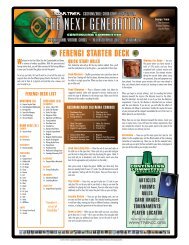Star Trek™ Customizable Card Game™ GLOSSARY
Star Trek™ Customizable Card Game™ GLOSSARY
Star Trek™ Customizable Card Game™ GLOSSARY
You also want an ePaper? Increase the reach of your titles
YUMPU automatically turns print PDFs into web optimized ePapers that Google loves.
in play – A card is “in play” if it<br />
• has been played or seeded face up; or<br />
• has been exchanged for a card already<br />
in play; or<br />
• has been activated by turning it face<br />
up (hidden agendas); or<br />
• has been encountered like a dilemma<br />
or during a Q-Flash; or<br />
• has been earned or acquired like an<br />
artifact (unless placed in the hand for<br />
later play);<br />
AND it has not left play.<br />
A card in play may leave play by being<br />
discarded (to the discard pile, bonus<br />
point area, The Next Emanation, etc.),<br />
placed out-of- play, re-seeded (e.g., with<br />
Q-Type Android), relocated as a marker<br />
(e.g., a completed objective such as<br />
Assimilate Homeworld), or returned to a<br />
player’s hand, draw deck, or side deck; it is<br />
then no longer “in play.” (A card such as<br />
Jem’Hadar Shrouding may also specify that<br />
certain cards are not in play.) Any cards<br />
placed on (or under) or played on (or<br />
aboard) that card are treated likewise<br />
(except cards which are exchanged for a<br />
card in hand or replaced by another card,<br />
and cards which are protected from Borg<br />
timeline disruption; see exchanging<br />
cards, Stop First Contact).<br />
Thus, a Personnel card is “in play” whether<br />
reported for duty, exchanged for another<br />
persona version, or recovered from an<br />
earned Cryosatellite. The personnel aboard<br />
a Cryosatellite are not “in play” until the<br />
Cryosatellite is earned and the personnel<br />
come aboard the ship. Personnel who are<br />
captured, in a Penalty Box, under The<br />
Nexus, “held” by a dilemma, or “lost” to<br />
Thine Own Self, are still in play.<br />
Game text may say that a Personnel card<br />
placed in the point area is in play for<br />
uniqueness only – if non-universal, you may<br />
not report another copy of that personnel<br />
(or another version of that persona). <strong>Card</strong>s<br />
in stasis or in a Temporal Rift or Time<br />
Travel Pod are also considered in play for<br />
uniqueness only. The skills and other<br />
features of such cards may not be used.<br />
For example, Kai Opaka placed in your<br />
bonus point area with Duranja does not<br />
prevent Orb artifacts from being nullified;<br />
while in a Temporal Rift, 10 and 01 cannot<br />
nullify Computer Crash and The Emissary<br />
does not enhance the INTEGRITY of<br />
Bajorans in play. However, you may not<br />
play another copy of Kai Opaka, 10 and 01,<br />
or The Emissary (or any other version<br />
of the Benjamin Sisko persona) under these<br />
conditions.<br />
When a personnel or ship leaves play, all<br />
previous effects on that card are cancelled<br />
(except use of a once per game function).<br />
If the same card is reported again, treat it<br />
as if it were a new copy of the card being<br />
reported. For example, replayed cards are<br />
“unstopped,” a ship is undamaged and any<br />
RANGE used this turn is restored, a<br />
personnel is no longer affected by Frame of<br />
Mind, and one who has already “walked”<br />
this turn can walk again. When an effect<br />
depends on another card “in play” or when<br />
another term not specifying “present,”<br />
“with,” or “location” is used, it may benefit<br />
from either player’s card (unless “your”<br />
or “opponent’s” is specified, as with<br />
Ressikan Flute or Flaxian Assassin).<br />
Examples:<br />
• Your opponent’s Kareen Brianon<br />
enhances your Ira Graves’ skills.<br />
• Your K’nera scores points if either<br />
player’s Korris or Konmel is killed in<br />
battle.<br />
• Disabled cards and cards in play for<br />
uniqueness only cannot trigger such<br />
effects.<br />
In the Zone – For this incident, the<br />
points you score during a turn are the net<br />
total of positive and negative points scored.<br />
The points that do not count toward<br />
winning are the last positive points scored<br />
during a turn in which you score more than<br />
50 points. For example:<br />
• You complete a mission for 45 points.<br />
Later that same turn, you complete a<br />
Cytherians dilemma for 15 points, for<br />
a total of 60 points. 10 of the 15<br />
Cytherians points do not count toward<br />
winning.<br />
• Reversing the previous example, you<br />
complete a Cytherians dilemma and<br />
then solve a 45-point mission on the<br />
same turn. 10 of the mission points do<br />
not count toward winning.<br />
• Continuing the second example, you<br />
then score -5 points from The<br />
Higher... The Fewer in the same turn.<br />
You now have a net total of 55 points;<br />
5 of the mission points do not count<br />
toward winning.<br />
The effects of In the Zone, Intermix<br />
Ratio, and Altonian Brain Teaser are<br />
independent; each one could affect the<br />
same points. If you are affected by more<br />
than one of these cards, evaluate your<br />
points that count toward winning for each<br />
card separately; the lowest total is your<br />
current “points that count toward<br />
winning.” Example:<br />
• You are affected by both Intermix<br />
Ratio and In the Zone. You solve a<br />
mission for 30 points and earn a<br />
Ressikan Flute with 9 Music personnel<br />
in play. Your actual score is 75. For In<br />
the Zone, 25 Ressikan Flute points do<br />
not count toward winning, for a<br />
“winning score” of 50. For Intermix<br />
Ratio, 15 points do not count towards<br />
winning, for a “winning score” of 60.<br />
In the Zone thus limits you to 50<br />
points counting toward winning.<br />
• Next turn you score 15 bonus points<br />
for a total score of 90. For In the<br />
Zone, 25 points still do not count<br />
toward winning, for a “winning score”<br />
of 65. For Intermix Ratio, 30 bonus<br />
points do not count toward winning,<br />
for a “winning score” of 60. Now<br />
Intermix Ratio is the card that limits<br />
your score to 60 points toward<br />
winning.<br />
incident – A card type similar to an Event<br />
card. It may play on and affect another<br />
card, or may play on the table to have a<br />
widespread effect on various aspects of the<br />
game. Most incidents have a lasting effect<br />
(unless the card is nullified or discarded<br />
according to its game text). A seedable<br />
incident may be seeded during any seed<br />
phase unless otherwise specified. Playing<br />
an Incident card uses your normal card<br />
play.<br />
Incoming Message – Federation, etc. –<br />
See outpost.<br />
Incoming Message: Attack<br />
Authorization – If you use this interrupt<br />
to attack your own ship when using a Battle<br />
Bridge side deck, you may draw and use a<br />
current tactic. The single current tactic<br />
applies to both the attacking and defending<br />
ships. However, if either of your ships is<br />
damaged, damage is applied as usual from<br />
your opponent’s Battle Bridge side deck (or<br />
rotation damage if he has no side deck).<br />
See battle – ship.<br />
infiltration icon <br />
– Your personnel who has a<br />
diamond shaped infiltration icon may<br />
infiltrate your opponent’s cards, if your<br />
opponent is playing that affiliation, in one<br />
of two ways:<br />
• It may report to your opponent’s side<br />
of the table, to a compatible facility<br />
(regardless of quadrant); or<br />
• It may report for duty normally, and<br />
infiltrate later in the game, during<br />
either player’s turn, if present with an<br />
opponent’s crew or Away Team<br />
compatible with that affiliation.<br />
If your opponent is not playing that<br />
affiliation, you may not infiltrate his cards<br />
with that personnel. See playing an<br />
affiliation.<br />
When your personnel starts infiltrating, its<br />
affiliation changes to match that of the<br />
infiltration icon and it becomes an<br />
infiltrator.<br />
• The infiltrator is part of your<br />
opponent’s crew or Away Team, but is<br />
still under your control. For example,<br />
your opponent may not treat the<br />
infiltrator as “his personnel” to benefit<br />
from his hand weapons. (Your<br />
infiltrator may not take your<br />
equipment into your opponent’s Away<br />
Team.)<br />
• Your opponent may not treat your<br />
Infiltrator as an intruder (e.g., his<br />
cards cannot initiate battle against<br />
your infiltrator, and vice versa).<br />
However, you may treat your<br />
infiltrator as an intruder for cards such<br />
as The Walls Have Ears.<br />
• Whenever any of the opponent’s<br />
personnel present take any action<br />
(e.g., beam, attempt a mission, initiate<br />
a personnel battle), your infiltrator<br />
may choose whether or not to<br />
participate (or to contribute to ship




